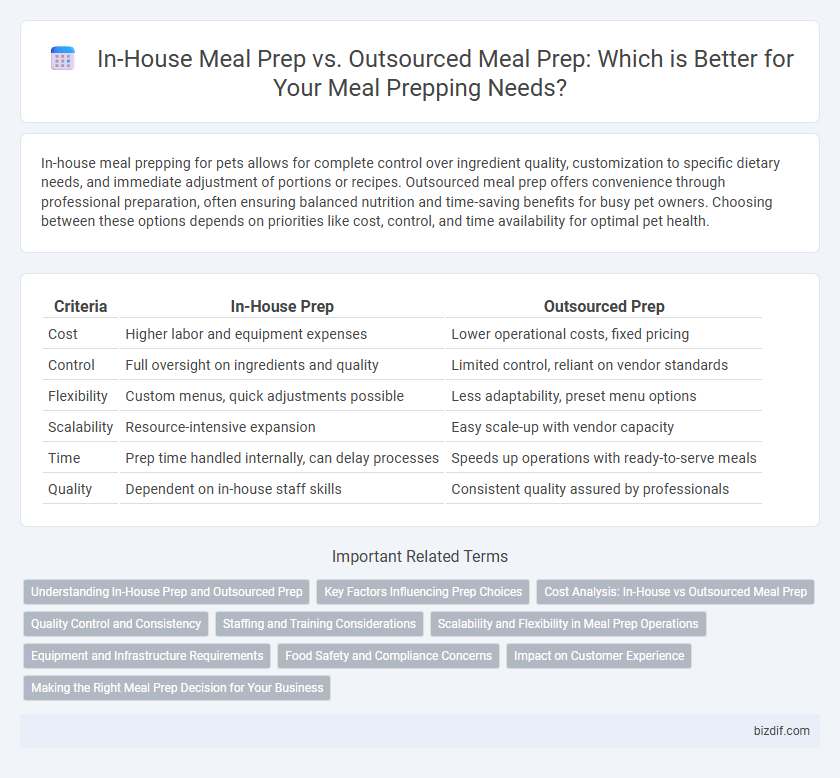In-house meal prepping for pets allows for complete control over ingredient quality, customization to specific dietary needs, and immediate adjustment of portions or recipes. Outsourced meal prep offers convenience through professional preparation, often ensuring balanced nutrition and time-saving benefits for busy pet owners. Choosing between these options depends on priorities like cost, control, and time availability for optimal pet health.
Table of Comparison
| Criteria | In-House Prep | Outsourced Prep |
|---|---|---|
| Cost | Higher labor and equipment expenses | Lower operational costs, fixed pricing |
| Control | Full oversight on ingredients and quality | Limited control, reliant on vendor standards |
| Flexibility | Custom menus, quick adjustments possible | Less adaptability, preset menu options |
| Scalability | Resource-intensive expansion | Easy scale-up with vendor capacity |
| Time | Prep time handled internally, can delay processes | Speeds up operations with ready-to-serve meals |
| Quality | Dependent on in-house staff skills | Consistent quality assured by professionals |
Understanding In-House Prep and Outsourced Prep
In-house meal prep involves preparing ingredients and meals within the organization's facilities, offering greater control over quality, customization, and food safety standards. Outsourced meal prep relies on external vendors or commercial kitchens to produce meals, which can reduce labor costs and enhance scalability but may limit customization and direct oversight. Choosing between in-house and outsourced prep depends on factors like budget, desired control, volume, and operational capacity.
Key Factors Influencing Prep Choices
Key factors influencing the choice between in-house and outsourced meal prepping include cost-efficiency, control over ingredient quality, and scalability of operations. In-house prep offers greater customization and ensures strict adherence to dietary requirements, while outsourced prep provides time savings and access to specialized expertise. Businesses must also consider logistical aspects like storage capacity and turnaround times to optimize their meal production strategy.
Cost Analysis: In-House vs Outsourced Meal Prep
In-house meal prep typically incurs higher upfront costs due to kitchen equipment, labor wages, and ingredient procurement but offers greater control over quality and customization. Outsourced meal prep reduces labor expenses and overhead by leveraging specialized vendors, often leading to bulk discounts and streamlined operations. Evaluating total cost of ownership, including hidden fees and scalability, is critical for optimizing meal prep budgeting strategies.
Quality Control and Consistency
In-house meal prepping offers superior quality control by allowing direct oversight of ingredient selection and preparation processes, ensuring consistent flavor and texture across batches. Outsourced prep often faces challenges maintaining uniform standards due to variable supplier practices and reduced real-time monitoring. Reliable in-house systems reduce the risk of quality fluctuations, fostering greater customer satisfaction and brand trust.
Staffing and Training Considerations
In-house meal prepping requires dedicated culinary staff with specialized training in food safety, portion control, and recipe consistency, demanding ongoing education to maintain quality standards. Outsourced prep shifts the responsibility of staffing and training to the third-party provider, often ensuring access to experienced professionals but limiting direct control over employee management. Evaluating the cost-effectiveness and quality assurance of both options is critical for operational efficiency and customer satisfaction.
Scalability and Flexibility in Meal Prep Operations
In-house meal prep offers greater control over quality and customization but may face limitations in scalability due to space and staffing constraints. Outsourced meal prep provides enhanced scalability by leveraging larger facilities and specialized teams, allowing quick adaptation to fluctuating demand. Flexibility in operations is higher with outsourcing, enabling businesses to adjust menu offerings and volume without significant capital investment.
Equipment and Infrastructure Requirements
In-house meal prep demands substantial investment in kitchen equipment such as commercial-grade ovens, refrigeration units, and food processors, alongside infrastructure that meets health and safety standards. Outsourced prep shifts these requirements to external suppliers, reducing upfront capital costs and ongoing maintenance responsibilities. Choosing in-house prep allows greater control over equipment customization, while outsourcing leverages specialized facilities optimized for large-scale production.
Food Safety and Compliance Concerns
In-house meal prepping allows for direct control over food safety protocols, ensuring compliance with local health regulations and reducing cross-contamination risks. Outsourced prep requires rigorous vetting of suppliers to confirm adherence to industry standards, certifications like HACCP, and regular third-party audits. Maintaining stringent monitoring systems and documentation is critical in both approaches to safeguard consumer health and meet regulatory requirements.
Impact on Customer Experience
In-house meal prep allows for tighter quality control and customization, enhancing customer satisfaction through fresh, tailored meals. Outsourced prep can speed up delivery times and reduce costs but may compromise consistency and limit customization options. Balancing these factors directly impacts the overall customer experience and brand loyalty.
Making the Right Meal Prep Decision for Your Business
Choosing between in-house meal prep and outsourced prep significantly impacts operational efficiency, cost management, and food quality control in your business. In-house prep offers greater customization and direct oversight, while outsourced prep reduces labor costs and scales easily with demand fluctuations. Analyzing factors such as staff expertise, budget constraints, and delivery timelines ensures the right meal prep decision aligns with your business goals and customer satisfaction.
In-House Prep vs Outsourced Prep Infographic

 bizdif.com
bizdif.com